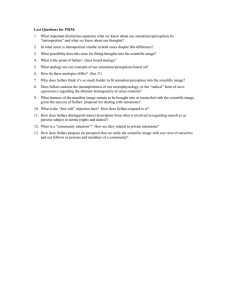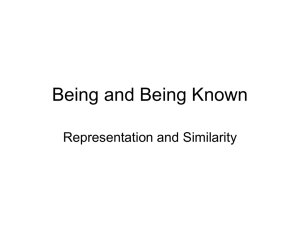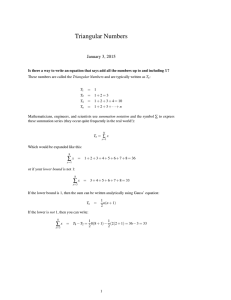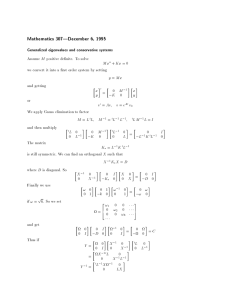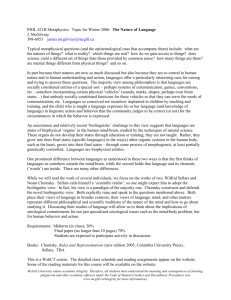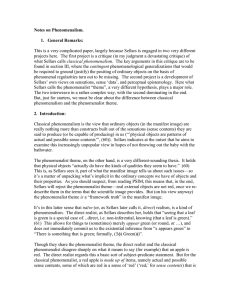Notes on BBK
advertisement
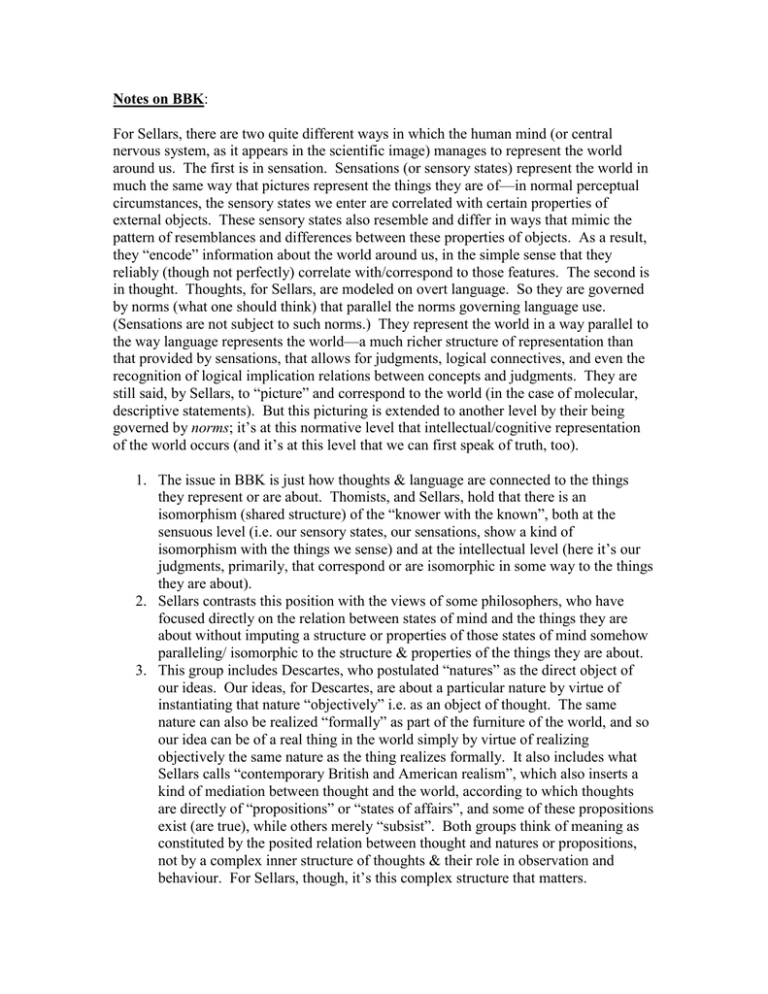
Notes on BBK: For Sellars, there are two quite different ways in which the human mind (or central nervous system, as it appears in the scientific image) manages to represent the world around us. The first is in sensation. Sensations (or sensory states) represent the world in much the same way that pictures represent the things they are of—in normal perceptual circumstances, the sensory states we enter are correlated with certain properties of external objects. These sensory states also resemble and differ in ways that mimic the pattern of resemblances and differences between these properties of objects. As a result, they “encode” information about the world around us, in the simple sense that they reliably (though not perfectly) correlate with/correspond to those features. The second is in thought. Thoughts, for Sellars, are modeled on overt language. So they are governed by norms (what one should think) that parallel the norms governing language use. (Sensations are not subject to such norms.) They represent the world in a way parallel to the way language represents the world—a much richer structure of representation than that provided by sensations, that allows for judgments, logical connectives, and even the recognition of logical implication relations between concepts and judgments. They are still said, by Sellars, to “picture” and correspond to the world (in the case of molecular, descriptive statements). But this picturing is extended to another level by their being governed by norms; it’s at this normative level that intellectual/cognitive representation of the world occurs (and it’s at this level that we can first speak of truth, too). 1. The issue in BBK is just how thoughts & language are connected to the things they represent or are about. Thomists, and Sellars, hold that there is an isomorphism (shared structure) of the “knower with the known”, both at the sensuous level (i.e. our sensory states, our sensations, show a kind of isomorphism with the things we sense) and at the intellectual level (here it’s our judgments, primarily, that correspond or are isomorphic in some way to the things they are about). 2. Sellars contrasts this position with the views of some philosophers, who have focused directly on the relation between states of mind and the things they are about without imputing a structure or properties of those states of mind somehow paralleling/ isomorphic to the structure & properties of the things they are about. 3. This group includes Descartes, who postulated “natures” as the direct object of our ideas. Our ideas, for Descartes, are about a particular nature by virtue of instantiating that nature “objectively” i.e. as an object of thought. The same nature can also be realized “formally” as part of the furniture of the world, and so our idea can be of a real thing in the world simply by virtue of realizing objectively the same nature as the thing realizes formally. It also includes what Sellars calls “contemporary British and American realism”, which also inserts a kind of mediation between thought and the world, according to which thoughts are directly of “propositions” or “states of affairs”, and some of these propositions exist (are true), while others merely “subsist”. Both groups think of meaning as constituted by the posited relation between thought and natures or propositions, not by a complex inner structure of thoughts & their role in observation and behaviour. For Sellars, though, it’s this complex structure that matters. 4. The view Sellars defends, then, is “to hold that acts of the intellect differ intrinsically qua (as) acts in a way which systematically corresponds to what they are about, i.e. their subject-matter.” (43) Nb. “Acts” here is a term of art. It refers not to actions but to actualities. Roughly, we can think of acts of the intellect as occurent (i.e. presently instantiated) states or features of the intellect. 5. Since Sellars thinks of thoughts on the model of language, we have to distinguish different kinds of thoughts (acts of the intellect) along linguistic lines: some thoughts are assertion-like (beliefs); some are singular-term like (ideas); some are question like (wonderings), etc. But he also wants to distinguish thoughts as acts (actualities, presently thought) from thoughts as mere potentials (grasped, understood, concepts that are “in our mental vocabulary”). This corresponds to the Thomist distinction between the intellect in first act (merely having the potential to apply a certain concept) and intellect in second act (actually applying the concept in some thought). 6. An aside: Sellars holds that at birth the intellect is in first act with respect to no concepts whatsoever, but he rejects the traditional (empiricist/abstractionist) account of concept acquisition (based on abstraction from experience). 7. The analogy between mental words and language is essential for Sellars’ account, but not for the Thomist account, which makes more of a meal of the “special” status of thoughts. 8. Three questions: What is a mental word? How do we come by them? (We need a developmental account of our acquisition of the ability to think…) How are they related to the “real order”? 9. The account of the Thomist view that follows (44) sounds pretty Cartesian: The mental word triangular is “the nature or form triangular as informing the possible intellect…A piece of wax becomes triangular through being informed by the nature triangular…the possible intellect becomes triangular [when it is representing some triangular thing] in the immaterial mode. 10. But (as I read it) the difference here is that while, for Descartes, thoughts are indistinguishable formally, and distinguished only by their contents, i.e. by what they are of, for the Thomists thoughts are distinguishable formally: being (immaterially) triangular is a real, formal property of thoughts, that is, the property of being immaterially triangular is conceived as a real property of thoughts that characterizes some thoughts (the thought of a white, triangular object) and that is analogous, in terms of its features & relations to other thought contents (compatibility with being immaterially red or blue, incompatibility with being immaterially square or pentagonal, including immaterially having three sides and interior angles summing to 180o), with the property of being materially triangular and its features and relations to other properties of things. 11. Sellars turns next to the issue of acquisition & whether abstractive accounts, which trace concept acquisition to sensory input & our ability to recognize/ generalize features represented to us sensorily, really work. The Thomists identify the mental word •triangular• with the sensory word •triangular •, and then suppose that our ability to think (immaterially) triangular thoughts is grounded in having had, at some previous time, the sensory word •triangular• as a sense-content (a “sensitive word”. Sellars is going to object here: for him the mental word •triangular• is analogous to the English word “triangular,” while the sensitive “word” •triangular• is analogous to the shape of (say) a yield sign. (In the first case, the analogy is at the level of the roles these “words” play in their respective languages; in the second, the analogy is at the level of the properties of our sensory states and the features of the things that normally produce such sensory states.) 12. What distinguishes the vocabulary of sense and the vocabulary of the intellect? See 45. 13. Abstraction, as a picture of how we come by (some of) our concepts requires that the sensory vocabulary and the intellectual vocabulary really overlap. Sellars rejects this: “…sense is a cognitive faculty only in the sense that it makes knowledge possible and is an essential element in knowledge, and that of itself it knows nothing. It is a necessary condition of the intentional order, but does not of itself belong to this order” (46) 14. Why do others confuse these? The quick move from sensing to judging is almost invisible, the role of senses in knowledge, but (most important) the “pseudointentionality” of sensations. 15. Here Sellars remarks first on the surface-language parallels between how we describe sensations (…of a white, triangular thing) and thoughts (…of a white, triangular thing). Second, the whiteness and triangularity of sensations is clearly not the same as the whiteness and triangularity of a (real) white triangle, any more than is the whiteness and triangularity of a thought. Finally, it’s clear that there is a role for “whiteness” and “triangularity” of some kind in our characterizations of sensory states. So it’s tempting, given two related projects (developing a theory of sense, and developing a theory of thought) in which we need a new kind of property somehow analogous to these properties of physical objects, to simply identify them. 16. But Sellars proposes an alternative, more limited account of the sense of “white” and “triangular” that applies to sensations. In this account, a sensation “of a white triangular thing” is a sensation which is: 1. Of a kind normally brought about by such things. 2. Of a kind that differs systematically from states normally brought about by objects of other colours and shapes. 3. Can be brought about by objects of other colours and shapes—a point which gets its real application in understanding how our senses sometimes mislead us. (47) 17. This sense of “white” and “triangular” is obviously not the ordinary one applying to physical objects. But it’s obviously related to that one, in a way that plays an important role in our understanding of our own perceptual psychology. And Sellars also regards these senses of “white” and “triangular” as developing out of the ordinary senses by a process of analogy. (Here the point made earlier, that for Sellars—unlike Descartes—direct self-knowledge can be essentially formulated in analogical terms. Our “reflexive knowledge” of our own mental acts, on this view, employs concepts that are not somehow privately “given” to us, but instead are “analogical extensions of concepts pertaining to the public or intersubjective world of things and persons. “So much the worse for Descartes”…) 18. The key to the analogy here is that the family of resemblances and differences between these analogically derived properties of sensations correspond to the family of resemblances and differences of properties of perceptible objects. So the place of “white” as a character of sensations, in the family of characters of sensations that we pick out with other colour words as well as shape words, matches up with, i.e. is isomorphic with, the place of “white” as a character of objects, in the corresponding family of characters of objects. 19. At this point Sellars remarks that the abstractive account of concept formation is no longer tempting at all: sensations don’t provide concepts for the intellect at all, on this account. They are merely a family of states of the human sensory system with a regular relation (in ordinary perceptual conditions) to the sensible properties of objects in the environment. As such, they are needed to explain perceptual knowledge, but they don’t embody knowledge at all, even in a limited, non-propositional “this white triangular thing” sort of way. 20. Now we turn to the intellect and the words of its vocabulary—including logical words, like ‘and’, ‘or’, ‘not’, etc. These logical words are used to build molecular sentences out of atomic sentences; the result, when we apply them to sentences about the world, is more sentences about the world. By contrast, logical words like implies, according to Sellars, turn (when we use them) sentences about the world into sentences about the “logical order.” This is, broadly, the system of inference relations that (normatively) govern reasoning within a given language. 21. This leads to a further critique of abstractive accounts of concept formation: if a concept like “white” is in the sensory vocabulary, and whiteness implies notredness, then it seems logical words like “not” are also there in the sensory vocabulary. Similarly for implication—we cannot grasp a concept unless we grasp its role in the inferences that link it to other concepts. We can’t escape the link between predicate concepts, like “white”, and predication itself, i.e. the assertion, of something, that it is white. So the attempt, on the part of Thomists, to limit the vocabulary of sense while preserving its identity with the corresponding words in the vocabulary of the intellect is untenable. 22. Finally, in the closing remarks of this first section, Sellars presents a kind of holist position on concept possession. The key here is language training—while actual perceptual judgements are essential to fully grasp a concept of a sensible property of objects, and so sensory exposure to white things is part of what it takes to acquire the concept “white”, this is only part of the process required—the rest of the process is a matter of learning the language of colour (and shape, too, ultimately).
